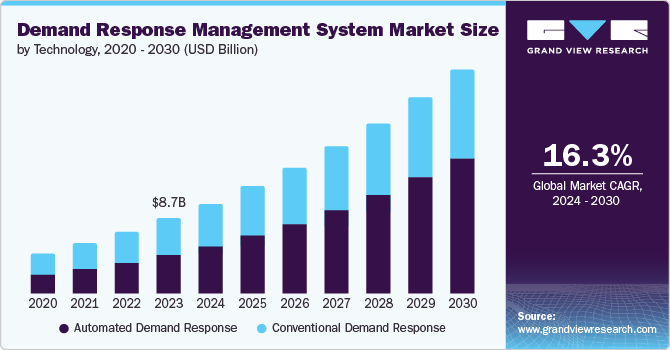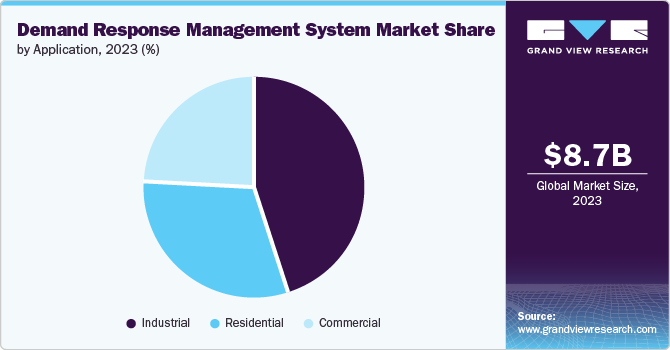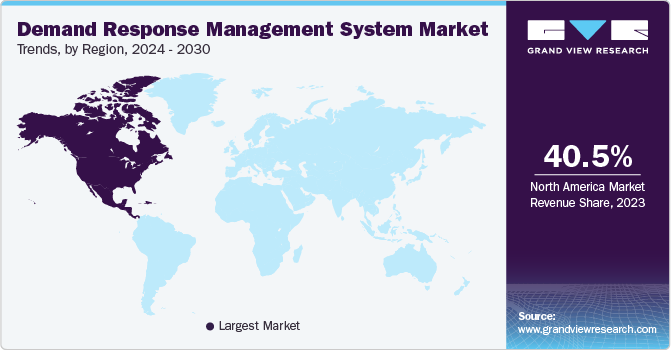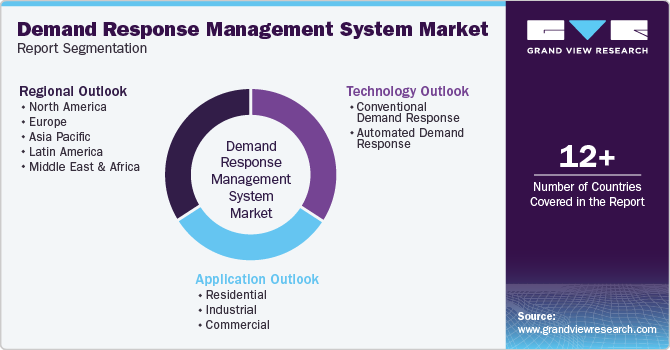
Demand Response Management System Market Size, Share & Trends Analysis Report By Technology (Conventional Demand Response, Automated Demand Response), By Application (Industrial, Commercial, Residential), By Region, And Segment Forecasts, 2025 - 2030
- Report ID: GVR-1-68038-789-6
- Number of Report Pages: 122
- Format: PDF
- Historical Range: 2017 - 2024
- Forecast Period: 2025 - 2030
- Industry: Technology
Market Size & Trends
The global demand response management system market size was estimated at USD 10.47 billion in 2024 and is expected to grow at a CAGR of 15.8% from 2025 to 2030, driven by increasing energy demand, a growing focus on renewable energy integration, and advancements in smart grid technologies. Demand response management system (DRMS) solutions enable utilities, industries, and consumers to manage electricity consumption dynamically, responding to grid conditions, pricing signals, or supply constraints. This enhances grid reliability, reduces energy costs, and supports environmental sustainability.

The rise of digitization in the energy sector, coupled with regulatory mandates promoting energy efficiency, has further accelerated DRMS adoption. For instance, in April 2024, EnergyHub partnered with CPower, virtual power plant (VPP), and national distributed energy resource (DER) monetization provider, and launched a new residential Virtual Power Plant (VPP) partnership, which is now available to 1.2 million Ameren Illinois customers across over 1,200 communities within the Midcontinent Independent System Operator (MISO) region, the U.S. midwestern grid operator.
In addition, the proliferation of Internet of Things (IoT) devices, advanced metering infrastructure (AMI), and real-time data analytics have made DRMS more efficient and scalable. The market has witnessed robust growth in regions like North America and Europe, where smart grid projects and renewable energy integration are prominent. Asia-Pacific is also emerging as a lucrative market due to rapid urbanization, industrialization, and government initiatives to modernize energy infrastructure.
Moreover, the integration of distributed energy resources (DERs), such as solar power and battery storage, is amplifying the importance of DRMS. These systems can orchestrate energy distribution effectively, ensuring seamless energy flow and preventing grid overloads. In the industrial and commercial sectors, DRMS solutions allow companies to implement flexible load management strategies, which contribute to significant energy savings while meeting sustainability goals.
Innovation in cloud-based DRMS platforms is another driver of market expansion, providing scalable and customizable solutions for diverse energy needs. These platforms enable utilities and consumers to automate demand response programs, monitor energy usage trends, and predict future energy requirements. As energy markets become more decentralized and consumer-driven, DRMS is positioned as a cornerstone technology in achieving energy efficiency, grid stability, and environmental sustainability. Its continuous evolution underscores its critical role in the global energy transition.
Technology Insights
The automated demand response segment led the market, accounting for over 52.0% share of the global revenue in 2024. Advancements in automation and IoT technologies are making ADR systems more efficient and scalable. These systems enable real-time, automated responses to grid conditions without the need for manual intervention. By automating demand response processes, ADR improves grid stability, reduces energy consumption during peak times, and helps utilities avoid high operational costs associated with peak load generation. For instance, in May 2024, Honeywell International Inc. introduced Honeywell Forge Performance+ for Utilities, a solution focused on helping utilities optimize operations and enhance the efficiency of their existing grid assets and IT systems. This integration of automation software aligns Honeywell's offerings with the broader trends of automation and energy transition.
The conventional demand response segment is predicted to foresee significant growth in the coming years. The increased need for grid stability and energy efficiency is driving the adoption of conventional demand response technologies. These systems help utilities manage peak demand by incentivizing consumers to reduce their energy usage during high-demand periods, thereby optimizing grid performance. As energy consumption continues to rise, especially in urban areas, utilities are increasingly relying on conventional DR technologies to prevent grid overload and reduce the need for additional infrastructure investments.
Application Insights
The industrial segment accounted for the largest revenue share in 2024. This growth is driven by several factors, particularly the increasing focus on cost reduction and operational efficiency in industrial operations. Industries, especially those with high energy consumption, are increasingly adopting DRMS solutions to optimize energy use during peak periods, thereby reducing their electricity bills. By shifting or curtailing energy consumption during high-demand times, businesses can avoid high electricity prices and improve overall cost efficiency.

The residential segment is predicted to foresee significant growth in the coming years. This growth is primarily driven by the increasing adoption of smart home technologies and the growing awareness of energy conservation and sustainability among consumers. The rise of smart appliances, smart thermostats, and IoT-enabled devices allows homeowners to monitor and control their energy consumption more effectively. These technologies enable automated energy adjustments during peak demand times, ensuring efficiency and cost savings.
Consumers are more inclined to adopt energy-efficient solutions as they become aware of the financial and environmental benefits of reducing their energy consumption. For instance, in January 2024, Honeywell International Inc. launched Advance Control for Buildings, a building management system that leverages existing wiring to provide building managers with enhanced control over operational efficiency, supporting improved occupant experience and advancing energy management objectives.
Regional Insights
North America demand response management system market dominated with a revenue share of over 39.0% in 2024. Various factors such as grid modernization and infrastructure investments, energy efficiency and sustainability goals, and increasing peak load management needs are primarily driving the growth of the North America DRMS market. Moreover, utilities are offering dynamic pricing models and real-time usage information to encourage customer participation in demand response programs. Furthermore, frequent extreme weather events in North America increase the need for grid resilience, where demand response can play a critical role in stabilizing energy supply during emergencies.

U.S. Demand Response Management System Market Trends
The demand response management system market in the U.S. is expected to grow at a CAGR of 14.7% from 2025 to 2030. U.S. commitments to reducing carbon emissions have intensified the shift towards clean energy. DRMS facilitates grid flexibility, aiding the integration of renewable energy sources such as wind and solar. States such as California, Texas, and New York have implemented aggressive renewable portfolio standards (RPS) and energy efficiency targets that promote demand-side management solutions.
Europe Demand Response Management System Market Trends
The Europe demand response management system market is expected to witness significant growth over the forecast period. The European Union's Green Deal aims to make Europe climate-neutral by 2050. This has resulted in stringent regulations to reduce carbon emissions and adopt cleaner energy solutions. DRMS enables efficient energy usage, aligning with decarbonization efforts. EU directives, such as the Energy Efficiency Directive, promote the adoption of demand-side flexibility solutions, including DRMS. This is supported by capacity mechanisms and market regulations encouraging demand response participation.
Asia Pacific Demand Response Management System Market Trends
The demand response management system market in the Asia Pacific region is anticipated to register rapid growth over the forecast period. The APAC region is experiencing rapid urbanization, with cities expanding rapidly to accommodate growing populations. This is leading to an increase in energy consumption, particularly in the industrial and residential sectors. As a result, utilities are looking for efficient methods to manage and optimize energy usage. DRMS solutions allow utilities to balance supply and demand more effectively, preventing overloading of the grid during peak hours and reducing the need for additional energy generation.
Key Demand Response Management System Company Insights
Some key companies in the demand response management system industry include ABB, Eaton, Enel Spa, ALARM.COM HOLDINGS, INC., and General Electric.
-
ABB offers real-time energy management solutions that enhance sustainability performance and reduce energy costs by continuously monitoring, forecasting, and optimizing energy consumption and supply across an entire facility or enterprise. The company operates through five business divisions, namely electrification, motion, process automation, robotics & discrete automation, corporate, and others. The company provides various demand response management systems, such as Ability Energy Management System (EMS), and Microgrid Power Management Controller.
-
Eaton is an intelligent power management company for protecting the environment. The company makes products for the utility, data center, commercial, industrial, residential, machine building, mobility, and aerospace markets. The company is well-positioned to leverage the energy transition, digitalization, and electrification. The company’s business segment is divided into the following: Electrical Americas and Electrical Global, Aerospace, Vehicle, eMobility, and Hydraulics. The company provides demand response management system products and services in the Electrical Americas and Electrical Global segments.
Key Demand Response Management System Companies:
The following are the leading companies in the demand response management system market. These companies collectively hold the largest market share and dictate industry trends.
- ABB
- Eaton
- Enel Spa
- ALARM.COM HOLDINGS, INC.
- General Electric
- Honeywell International Inc
- Itron Inc.
- Johnson Controls, Inc.
- Schneider Electric SE
- Siemens
Recent Developments
-
In September 2024, Eaton launched the AbleEdge home energy management system, providing installers and homeowners with a comprehensive, easily installed, and fully integrated solution designed to streamline a safe energy transition. Its home energy management solutions enable enhanced flexibility and energy resilience, catering to both retrofit and new construction projects through advanced smart breakers, a microgrid interconnect device and smart panels.
-
In September 2024, Johnson Controls launched Metasys, Building Automation System of industrial, commercial, and institutional buildings. Metasys 14.0 is developed to optimize the performance and sustainability of commercial buildings while prioritizing occupant comfort, health, and safety. Leveraging the established Metasys platform, it introduces advanced features that enhance user experience, improve network efficiency, flexibility, and security, streamline administrative processes, and support effective energy management.
-
In May 2024, Honeywell International Inc. partnered with Enel North America to enhance demand response and building automation solutions for industrial and commercial organizations by using automation to regulate and control energy loads to stabilize the power grid.
Demand Response Management System Market Report Scope
|
Report Attribute |
Details |
|
Market size value in 2025 |
USD 12.44 billion |
|
Revenue forecast in 2030 |
USD 25.92 billion |
|
Growth rate |
CAGR of 15.8% from 2025 to 2030 |
|
Actual data |
2017 - 2024 |
|
Forecast period |
2025 - 2030 |
|
Quantitative units |
Revenue in USD billion/million and CAGR from 2025 to 2030 |
|
Report coverage |
Revenue forecast, company ranking, competitive landscape, growth factors, and trends |
|
Segments covered |
Technology, application, region |
|
Regional scope |
North America; Europe; Asia Pacific; Latin America; MEA |
|
Country scope |
U.S.; Canada; Mexico; Germany; UK; France; China; India; Japan; Australia; South Korea; Brazil; UAE; South Africa; KSA |
|
Key companies profiled |
ABB; Eaton; Enel Spa; ALARM.COM HOLDINGS, INC.; General Electric; Honeywell International Inc; Itron Inc.; Johnson Controls, Inc.; Schneider Electric SE; Siemens |
|
Customization scope |
Free report customization (equivalent up to 8 analysts working days) with purchase. Addition or alteration to country, regional & segment scope. |
|
Pricing and purchase options |
Avail customized purchase options to meet your exact research needs. Explore purchase options |
Global Demand Response Management System Market Report Segmentation
This report forecasts revenue growth at global, regional, and country levels and provides an analysis of the latest industry trends in each of the sub-segments from 2017 to 2030. For this study, Grand View Research has segmented the global demand response management system market report based on technology, application, and region.

-
Technology Outlook (Revenue, USD Billion, 2017 - 2030)
-
Conventional Demand Response
-
Automated Demand Response
-
-
Application Outlook (Revenue, USD Billion, 2017 - 2030)
-
Residential
-
Industrial
-
Commercial
-
-
Regional Outlook (Revenue, USD Billion, 2017 - 2030)
-
North America
-
U.S.
-
Canada
-
Mexico
-
-
Europe
-
UK
-
Germany
-
France
-
-
Asia Pacific
-
China
-
India
-
Japan
-
Australia
-
South Korea
-
-
Latin America
-
Brazil
-
-
MEA
-
UAE
-
South Africa
-
KSA
-
-
Frequently Asked Questions About This Report
b. The global demand response management response system market size was estimated at USD 10.47 billion in 2024 and is expected to reach USD 12.44 billion in 2025.
b. The global demand response management response system market is expected to grow at a compound annual growth rate of 15.8% from 2025 to 2030 to reach USD 25.92 billion by 2030.
b. North America dominated the demand response management response system market with a share of 40.3% in 2024. Various factors such as grid modernization and infrastructure investments, energy efficiency and sustainability goals, and increasing peak load management needs are primarily driving the growth of the North America DRMS market. Moreover, utilities are offering dynamic pricing models and real-time usage information to encourage customer participation in demand response programs.
b. Some key players operating in the demand response management response system market include ABB, Eaton, Enel Spa, ALARM.COM HOLDINGS, INC., General Electric, Honeywell International Inc, Itron Inc., Johnson Controls, Inc., Schneider Electric SE, Siemens
b. Key factors that are driving the market growth include integration of electric vehicles in smart grid, rapid installation of smart meter, especially in the residential sector, and integration of Distributed Energy Resources (DER), and roll-out of smart grids which has increased the application of Advanced Metering Infrastructure (AMI).
We are committed towards customer satisfaction, and quality service.
"The quality of research they have done for us has been excellent."




